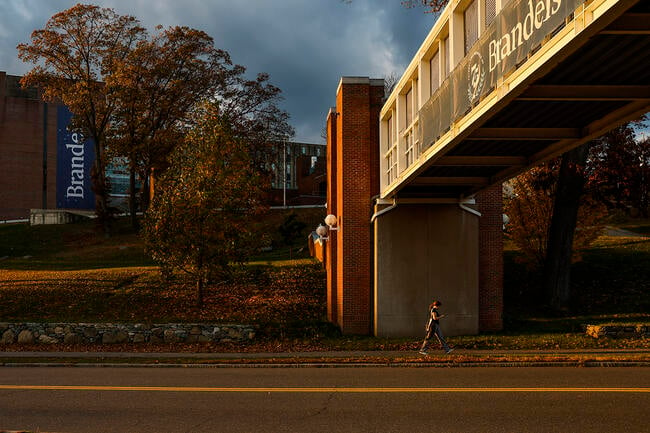You have /5 articles left.
Sign up for a free account or log in.

Numerous colleges across the country, including Brandeis in Massachusetts, are embedding career readiness across their curricula.
Erin Clark/The Boston Globe/Getty Images
In an increasingly tough job market for new graduates, Brandeis University has joined a legion of higher education institutions focusing on skills development and career readiness to prepare students for life after college.
With a $25 million investment from its Board of Trustees and overwhelming faculty support, the wealthy, selective liberal arts university in Massachusetts will unroll a revamped, skills-focused curriculum next fall.
“We are living through a time of extraordinary change across technology, the economy and society,” Brandeis president Arthur Levine said last week at an event in Washington, D.C., where he unveiled the university’s plan to “reinvent” the liberal arts. “Today’s students need more than knowledge. They need the skills, experiences and confidence to lead in a world we cannot yet predict. We are advancing a new model. We need reinvention. And that’s exactly what Brandeis is establishing.”
Time will tell how much the university’s strategy will transform the liberal arts, but Brandeis joins a growing group of institutions making deliberate moves toward career preparation as skepticism of graduate outcomes grows, tuition rises and the public questions the value of a college degree.
In Washington, the Trump administration is on a crusade to make colleges more skills-focused and has committed federal aid dollars to short-term programs through workforce Pell. Meanwhile, the rise of generative artificial intelligence is spurring labor force experts to predict it will shrink demand for entry-level white-collar workers in some industries.
For its part, Brandeis plans to open a Center for Careers and Applied Liberal Arts and assign every undergraduate student to a career and an academic adviser in their first semester. All students will be required to complete at least one internship, apprenticeship or other applied learning experience. Students can earn digital badges in classes and co-curricular activities to verify the skills they’re learning. In addition to academic grades, students will receive a career competency transcript listing the skills they acquired through their traditional courses.
“We’re living during a time in which the half-life of knowledge is getting shorter and shorter and strict vocational skills have a very short window,” Levine, who co-authored The Great Upheaval: Higher Education’s Past, Present, and Uncertain Future, said in an interview with Inside Higher Ed. “We need to give students a stronger set of skills if they’re going to get a job and hold a job. The world is going to be upskilling, reskilling and newskilling in the years to come.”
‘Connecting the Dots’
Alongside experiential learning, several other institutions have launched cross-curricular initiatives designed to equip students with transferable skills and the ability to articulate them to potential employers.
“A lot of higher education institutions are already teaching students these transferable skills, but if we’re not explicitly connecting those dots, it leads too much up to chance,” said Brenna Gomez, director of career integration at Oregon State University, which recently launched a reworked general education curriculum that infuses career development throughout the university experience.
Starting this past summer, new students at OSU are required to learn how their college education and outside-the-classroom experiences connect to their career aspirations. They must also participate in experiential learning, such as job shadowing, internships or undergraduate research. According to Gomez, the new program is meaningful for students and their families.
“Parents feel that guarantee that students will have opportunities to connect with employers and career advisers throughout the year,” Gomez said. “We want to make sure students have had time to intentionally reflect on it while they are here in multiple different ways so they have the confidence to speak to these skills on their résumés and in their interviews.”
Georgia State University is also piloting a new cross-curricular microcredential framework to help students track their skills and accomplishments through standardized microcredentials.
“The strategies we’re using are additives, not replacements. Higher education has always adapted curricula to meet new societal needs, and what’s different now is the urgency and the tools,” said Nancy Byron, assistant dean of academic innovations, partnerships and marketing at Georgia State. “We see microcredentials as a way to connect academic strengths with workforce needs. If we can build these stackable, visible and employer-recognized pathways, we’re hoping learners can succeed in college, their careers and their communities.”
Getting Faculty Approval
But pivoting to a career-focused curriculum requires faculty buy-in, said Tim Leslie, vice president of strategic planning and career development and executive director of impact at Beloit College. In 2023, the liberal arts college in Wisconsin launched Impact Beloit, an initiative aimed at getting students career-ready in part by having faculty and staff bring community-based learning to the classroom.
“You have to get faculty on board with the idea that they’ve always prepared students for a career, but now they’re doing it more explicitly and intentionally,” Leslie said. “We had buy-in from the faculty for us to talk about résumés and career readiness in class.”
At Brandeis, 88 percent of faculty endorsed the university’s new direction, including the integration of professional programs with traditional liberal arts disciplines. The college has created four new schools: the School of Arts, Humanities and Culture; the School of Business and Economics; the School of Science, Engineering and Technology; and the School of Social Sciences and Social Policy.
“There were a lot of hard discussions about it, but a semester’s worth of conversations led to a pretty high margin of approval, which was both surprising and exciting” said Jefferey Lenowitz, a political science professor at Brandeis and chair of the Faculty Senate.
He said the new structure will create possibilities for teaching and research. “It also brings faculty together from the different schools; students will be able to connect with more faculty and it will hopefully become an engine of innovation.”
Bridget Burns, CEO of the University Innovation Alliance, which helps institutions implement scalable student success initiatives, said helping students prepare for future careers doesn’t require multimillion-dollar investments.
“This is work that is doable no matter the institution size or type,” she said. “It’s about designing the experience of making it possible and sustainable for faculty to reflect and take the things they have done in small, one-on-one settings and embed it in the syllabus. That’s what’s happening here.”



